
When a Mommy-robot and a Daddy-robot love each other very much, they, uh, hey — what do robots do to make new robots?
Various reproduction methods for the Transformers species have been demonstrated across various continuities.
Mechanical construction[]
Sometimes, new Transformers are simply built from scratch, and that's all it takes. A suitable Transformer body is constructed, and when finished and turned on, it just springs to life. Two notable examples of this type of reproduction appear in the Generation One cartoon: when Wheeljack and company create the Dinobots, and later when the temporarily super-intelligent Grimlock creates the Technobots.

"I've been workin' on the Dinobot, all the live long day..."
The Dinobots are initially very simple mentally and are ordered to be deactivated because they are too dangerous. Wheeljack then develops a set of crown-like devices to place on the Dinobots which greatly enhances their intellect, although they are still "dumb" and childlike compared to the other Autobots. The Technobots, on the other hand, are immediately fully functional, and some of them are even smarter than average Transformers. If one were to take these facts as canonically meaningful (rather than simply the whims of the writers of those episodes), it could be guessed that programming a functional Transformer brain from scratch is extremely difficult, such that even Wheeljack is not up to the job. Temporarily super-genius Grimlock may be the only one capable.
At least on the surface, this "built from scratch" approach runs counter to claims in other episodes of the show that Vector Sigma is needed to create new Transformer life. (See below.) However, since Vector Sigma is presented as being a supercomputer and not a "magical" device like the comics' Creation Matrix, it could fall in with the speculative statements above regarding Grimlock and Wheeljack. Perhaps Vector Sigma is simply an advanced enough computer that it is capable of constructing a working mind.
Infusion[]

Go on, rub it and make a wish.
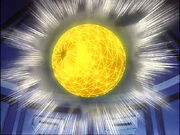
Vector Sigma holds "Disco Night" every Friday at 11 pm.
In other stories, once a new Transformer body has been built, it must still be infused with life (what the fiction from the Beast era and after would gloss as a spark) from a "god-like" outside source. In the Generation One cartoon, this source is Vector Sigma; in the Marvel comics, it is the Creation Matrix, which houses the essence of Primus, the Transformers' creator-god. In the Beast era cartoons, sparks arrive from the Allspark, perhaps through Vector Sigma. (In many continuities, each Transformer's life force is a fragment of Primus's own.) The live-action movie continuities function with the All Spark being the source of infusion as well, though in that case, "living" and "sentient" are not quite the same thing. (See: Real Gear Robot.)
In the Young Corgi book Desert of Danger, Hot Rod refers to his creation after the Ark left Cybertron as when he was "matrixed". How exactly this would have happened if Optimus Prime was aboard the Ark with the Matrix at the time is unknown, but one option might be the Matrix Flame.
The Matrix Flame is an artifact which allows Transformers on Cybertron to access the power of the Matrix even when it is no longer on Cybertron. Literally a flame, it is used to breathe life in the super warrior Ultra Magnus in the UK comics. The flame is somehow linked to the Matrix, and when the Matrix is transported to another dimension during "Target: 2006", the flame goes out, forcing the Autobots on Cybertron to investigate.
The Dreamwave More than Meets the Eye guide provides yet another method of infusion. According to the guide, in Dreamwave continuity, Transformers generally begin life as a skeletal mass of partially formed circuits—a Protoform. These are kept in stasis pods filled with nurturing nutrient gel. They can be built to certain specifications or be fairly general, allowing the robot to form naturally upon introduction of a spark. Sparks, and hence life, usually come from the Matrix, *BUT*, if the Matrix is absent, life can be granted by attuning the protoform to an energy wavelength similar to the Matrix and then applying a concentrated burst of energon. This alternative is rarely used, as it is extremely resource-consumptive, requiring restrictively high amounts of energon.[1]
The Movie continuity's Allspark works by infusion as well, just on an even more impressive scale. It is capable of infusing any inanimate machine with life and simultaneously altering its structure so that it is capable of transforming into a Cybertronian-style robot. The Allspark fragments spread across Detroit in the Transformers: Animated continuity show the same ability to alter non-living machines into new Transformers (as well as unrelated powers like slowing time and remote controlling other Cybertronians.) Although, outside of the toy biographies for certain characters, the Allspark in the movie merely creates non-sentient, animalistic life-forms out of ordinary machines, rather than fully developed Cybertronians. Suggesting that maybe, the Cybertronians 'evolved' over time. This is further hinted at by Optimus Prime when, whilst responding to Ironhide's comment about Humans being primitive and violent, he replies; 'were we so different?'
Resurrection[]
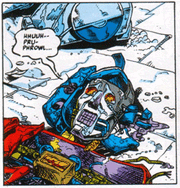
Don't worry kids, he gets better. Again.
Though not quite the same as reproduction, a copy of the mind or essence of a previously living Transformer may be introduced into a new body and, through some vague process, return that Transformer to life. This occurs when Starscream creates the Combaticons in the G1 cartoon, and in the comic when Prime uses copies of the minds of existing Cybertronians to create the second-series Autobot cars on Earth. Another example from the comic occurs when Optimus Prime himself is returned to life merely by inputting a human's floppy disk copy of his mind into a new body.
A variation on this theme is Unicron's ability to create new Robotic life. In the cartoon continuity, Unicron rebuilds Megatron into Galvatron, though it is unclear if these are the same being. Less ambiguous is the creation of Cyclonus, Scourge and the Sweeps from the apparently dead remains of Skywarp, Thundercracker and the Insecticons. In Marvel comic book continuity, Unicron exhibits a similar ability, fashioning three servants named Hook, Line, and Sinker from the remains of non-Cybertronian robots attempting to flee him. Some fans have speculated that the creation of the Technobots by super-genius Grimlock was aided in some fashion by Unicron's presence.
In his ending to the Beast Wars: Transmetals video game, Ravage uses "a prototype cloning device, based on transreplication technology" to clone the deactivated G1 Decepticons on the Ark into new protoform bodies, thus reviving them without altering the timeline (and erasing himself) by effectively doubling each robot.
This is included as a means of reproduction because it seems likely from the dialogue that the Autobot cars created via copied minds by Prime on Earth still existed on Cybertron when he left, meaning that if they survived the intermediate 4 million years, two of each of these individuals now exist.
In the Unicron Trilogy story "Linkage", Redline and Falcia combine energy from their spark frames in order to create a new body for the mind/soul of Twirl to inhabit after her Mini-Con storage panel is destroyed in battle. This leads to an interesting relationship between Twirl and Falcia. (See "Familial relationships", below.)
Budding[]
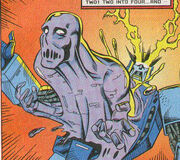
Budding doesn't look like much fun at ALL. It looks like Aliens versus Predator all over again.
The Transformers: Generation 2 comic introduced the concept of asexual "budding". Bubbles and lesions of apparently liquid metal form on a robot's chest, accompanied by energy discharge. The process grows more intense, until a large mass of liquid metal bursts free from the chest and slowly forms into a protoform-like blank figure, and then solidifies into a full Transformer. Illustrations suggest that this is something of a communal event, with others surrounding the budding robot in a circle.
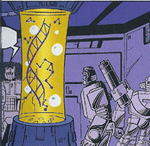
With the right early screening, even pegwarming might some day be preventable.
It was revealed that (in the Marvel continuity at least) early Transformers reproduced this way until they reached the population level Primus desired. At this turning point, the practice stopped and all memory of it was erased. When the Cybertronian Empire (possibly under influence of the Liege Maximo) rediscovered and revived the process sometime during the 4 million years after the Ark's loss, the successive generations of robots produced were increasingly less sentient and emotional (as Primus's lifeforce was apparently spread thinner and thinner between them), and the lifeform called The Swarm was created as a byproduct.
It is established here that Transformers do have genetic material (the Transformer equivalent of DNA) within their cellular structures. (Yes, they also apparently have cellular structures—who knew?) This genetic material is passed down from "parent" to "child" through budding. Its make-up is seen in the picture on the left. (Apparently, its design is not taught in the Transformer equivalent of high school Biology, as Megatron does not recognize what he's looking at until Perceptor explains.) This genetic material and basic Transformer cellular structure is also passed to the Swarm. Later, in IDW continuity, Transformer genetic material is given the designation CNA, and it is what is altered by the malevolent Jhiaxus to create female Transformers.
The other notable fact is that Transformers who have undergone the budding process retain some sort of primal link to their offspring, thus even though they are galaxies apart, the G1 Decepticon Onslaught doubles over in pain when his descendant Mindset is destroyed, and the Liege Maximo says he would know if his descendant, Megatron, were to die.
Sexual reproduction[]
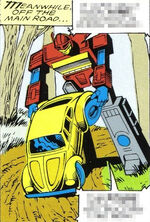
"Film the birth?" "No, got some great footage of the conception, though!"
- "Oh, yeah, yeah, scoutin' the enemy, heh heh. So...find any new positions?"
- ―Rattrap being a pervert in The Agenda (Part 1)
Despite most continuities having male and female genders (gender being a mental and social classification, as opposed to "sexes", a physical distinction) and a definite, strong history of romance existing between these genders, there is little canonical evidence for Transformers reproducing sexually. (Though admittedly, there isn't a lot of direct evidence for humans reproducing sexually in most Transformers media, which is, after all, aimed towards kids.)
In the Generation One cartoon, the male Transformer—female Transformer romance could perhaps be explained as an artifact of Quintesson mental programming very closely echoing the organic life forms the Transformers were built to serve.
On only two occasions in Generation One do we get a hint of male and female Transformer romance leading to the formation of family units and the creation of offspring. The first is subtle: Wheelie's backstory in some versions mentions his crashing on Quintessa with his parents. The second is more explicit: At the end of the Japanese Victory manga, we find out that Deathsaurus and his forces have been fighting all this time for the sake of his wife Esmeryl, the wives and sisters of the other Decepticons, and all their many children. Awww.
Apart from this, the best case for sexual reproduction in the species could probably be made from Beast Wars, where Rattrap makes numerous off-color remarks throughout the series, especially directed at Silverbolt and Blackarachnia. These comments strongly hint at something sex-like among Transformers, though it could, of course, be merely recreational rather than reproductive.
During the events of the Theft of the Golden Disk, Cryotek also mentions that he was 'as fond of Megatron' as if he were his own son. This seems to imply a definite familial relationship existed within the Transformer race, even if it be an 'adopted' one.
Airazor and Tigatron's fusion into Tigerhawk during Beast Wars could perhaps be seen as an example of sex-like reproduction (i.e., two beings coming together and creating a new being that is a recombination of their components). In the case of these two it was not only their physical bodies that came together, but also their sparks, which from two different sparks merged into a single one (process that can be compared to the fusion of the nuclei of the gametes of organic living beings). However It could also just be glossed as an extension of the usual Combiner-team type merger. Although, it is still unknown if the Sparks of those who join together in a Combiner can actually fuse, and there is also the fact that the union to form a Combiner can be reversed.
It is unknown what effect the Beast Machines reformatting of Transformers into technorganic beings, which are equal parts organic life and mechanical structure down to a cellular level, has on their reproductive options. It is conceivable but unexplored whether this new form of Transformer life could reproduce sexually.
It should be noted that during a dream-like vision, Blackarachnia and Silverbolt meet in an ethereal state, and the two appear to "merge" their sparks, which may be as close to sexual intercourse as Transformers get, perhaps a more spiritual act than physical. Sparks' fusion can also be compared, metaphorically, to the fertilization process, the fusion of gametes from organic beings.
The comparison of sparks with reproductive cells of organic beings does not end here. Much like a human zygote, a spark can, either naturally or through artificial induction, split into two healthy but inextricably linked sparks. The resulting Transformers are considered twins and possess a "branched" or "split" spark. Skids and Mudflap, are an example of two twins.
The 2007 motion picture once again brings up questions about the possibility of a less-than-mechanical form of reproduction. The first and most obvious of these implications comes from Ratchet's less-than-tactful observation of "the boy want[ing] to mate with the female." Although his grasp of the concept could stem merely from a familiarity with organic species in general, it does however make it clear that Cybertronians have an understanding of both gender and sexuality. Optimus Prime's mention of Megatron killing their father, in some related material does suggest Transformers have some understanding of family units.
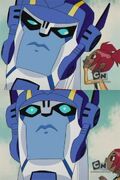
At that moment, Optimus realizes that there are some questions best left unanswered.
In the Transformers Animated continuity, it seems clear that Transformers do not reproduce sexually. Optimus Prime appears stunned when Sari tells him where human babies come from.[2]
On another note, Animated Omega Supreme does not know what a "dad" is.
On the flip-side, in IDW continuity, female Transformers are specifically created by Jhiaxus. By altering fundamental CNA Jhiaxus introduced gender to the species from a malevolent curiosity about what would happen. The depth of the change in this case is unknown, is it limited to appearance and mentality or does it go deeper? If he was truly trying to see how females would affect the evolution of the species it is possible Arcee was created with the capability for some analog of sexual reproduction in mind, but given his abandonment of the experiment and Arcee's resultant unbalanced mental state it seems unlikely the depth of the change will be explored.
Also note that during one scene of Revenge of the Fallen, Starscream speaks about the hatchlings, and soon after a large egg-sac is cut open, causing what appears to be a Cybertronian infant to fall out.
Familial relationships[]
One confusing aspect of this apparent lack of sexual reproduction is the canonical use of genealogical terminology to describe certain relationships. The most common of these is when two Transformers regard each other as siblings: "brothers" (e.g. G1's Sideswipe and Sunstreaker, Energon Shockblast and Six Shot, Movie Skids and Mudflap, Animated's Jetfire and Jetstorm, Robots In Disguise's Optimus Prime and Ultra Magnus), Prime Skyquake and Dreadwing, or "sisters" (Roulette and Shadow Striker).
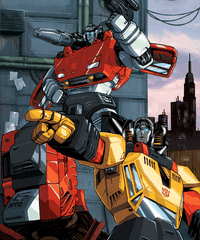
The Doublemint Twins they're not.
Again, the Dreamwave More than Meets the Eye guide provides a partial possible answer. According to the guide, when a spark naturally splits as it's being introduced to a protoform, it creates two robots who are "brothers", such as Sideswipe and Sunstreaker. When such a spark division is artificially induced, the less balanced and less self-reliant pair created is referred to as "clones". (This definition of "brother" may or may not apply to RID Prime and Magnus, whose brotherhood was said to result from the special circumstance of having been created simultaneously by Alpha Trion). Another example of Transformer siblings exists with Six Shot and Shockblast where Six Shot claims to be Shockblast's brother because they shared the same mold (body shape). Another case is Skyquake and Dreadwing who, although are separate individuals, share the same mold as well as half of the same Spark. This connection allowed one to feel significant events that occurred to the other over great distances (up to several light years).
However, the "Beast era" widened the issue of reproduction with Rattrap referring to his "great-aunt" Arcee and in general the practice of Maximals and Predacons referring to the Autobots and Decepticons as their respective "ancestors", as well as themselves as being their "descendants", implying a direct genetic (for want of a better term) lineage. Various sources of debatable canonicity suggest that Optimus Primal is specifically descended from Optimus Prime, usually through the phrase "his ancestor Optimus Prime" (though the events of Optimal Situation seem to prove that all Maximals could reasonably consider Optimus Prime their ancestor). In "Theft of the Golden Disk", Cryotek refers to Megatron that he is "as fond of him as is he were his own son".
In the absence of sexual reproduction, the use and meaning of these genealogical references is difficult to explain. One possible explanation might be a situation such as when Airazor is brought to life in Beast Wars. Her spark and protoform are heavily damaged, and Cheetor allows some of his parts to be used as replacements while Rhinox guides the procedure. To compare to humans, this is something like assisting with childbirth and donating blood or organs. It is unlikely that this happened enough to cause "descendants" as they are described, however. The term may also be used in an ideological sense or even a technological sense, much as the CD or MP3 player is, in a way, a "descendant" of the gramophone.
Other family designations exist as well. Wheelie has "parents" that were lost in his crash on Quintessa, according some background material. The aforementioned Mini-Con Twirl very specifically calls Falcia her "mother" (which Falcia hates) and seems to treat Redline like a father, since the two's spark frame energies went into constructing her physical form. In the Armada cartoon, Side Swipe refers to Hot Shot as his brother after Hot Shot saves his life, indicating at least an understanding of the concept. The Unicron Trilogy universe has also used the term "cousin" for certain Transformers on occasion. The Japanese Generation One Victory manga features Decepticon wives and children. In the live-action movie Optimus calls Megatron his brother, and it is mentioned in the related Nintendo DS game that Megatron "took the spark" of their father. However, in the supplemental works and in interviews, it was revealed this was meant to be more a "brother in arms" then an actual relation. Jetfire even states that he had a father and a mother, and that his father was the first wheel. This indicates that both a male and a female Transformer is needed to reproduce.
See also: Relatives
Toys[]
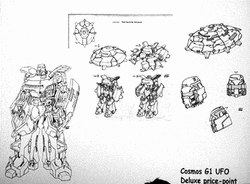
Echography of a sadly aborted Transformer. Yes, those things happen.
In the real-life continuity, when two toy manufacturing companies love each other very much, one of them may start shooting Transformer design propositions to the other one. There, during several months of gestation, engineers will work on those designs, which will be developed into functional and manufacturable Transformers. Once the Transformer is ready to be produced, its design will be sent to marketing and ultimately to the chain manufacturer for the delivery. Voilà! A new Transformer is born!
Footnotes[]
- ↑ More Than Meets The Eye #8, "Cybertron: Protoforms" (2003)
- ↑ Of course, for all we know, she might have whispered, "We buy them on eBay." Or worse.
